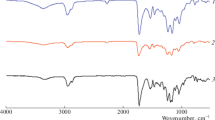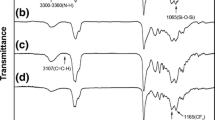Abstract
Intrinsic cross-linked waterborne polyurethane (CWPU) was successfully synthesized for the first time through solvent-free condensation polymerization, in which green castor oil (CO) was used as the cross-linking agent. The totally solvent-free process was realized by using hydrophilic polypropylene glycol as hydrophilic segment, which was synthesized by the esterification of polypropylene glycol with pyromellitic dianhydride. The effect of CO content in the soft segment of the prepared CWPU on emulsion properties was investigated by laser particle size distribution test, and the prepared CWPU emulsion showed uniform size distribution (0.117–0.275 µm) and milky white appearance after storing at ambient temperature for 6 month. Additionally, the effect of CO content in CWPU films on static mechanical properties, dynamic mechanical properties, hydrophilicity and thermal stability was also studied by tensile test, dynamic mechanical analysis, water absorption and contact angle measurement as well as thermogravimetric analysis. The prepared cross-linked CWPU films have good stability and outstanding mechanical strength (11.94–34.51 MPa), making them adequate supplement for the conventional waterborne polyurethanes.








Similar content being viewed by others
References
Pan WC et al (2015) Solvent-free processes to polyurea elastomers from diamines and diphenyl carbonate. J Polym Res 22:1–11
Mannari VM et al (2006) Two-component high-solid polyurethane coating systems based on soy polyols. JCT Res 3(2):151–157
Billiani J, Wilfinger W (2002) New low-VOC acrylic polyol dispersions for two-component polyurethane coatings. Surf Coat Int Part B Coat Trans 85:191–195
Gurunathan T et al (2015) Effect of reactive organoclay on physicochemical properties of vegetable oil-based waterborne polyurethane nanocomposites. RSC Adv 5:11524–11533
Dvorchak MJ et al (1997) Using “High performance two-component waterborne polyurethane” wood coatings. J Coatings Technol 69:47–52
Chen R et al (2014) Anionic waterborne polyurethane dispersion from a bio-based ionic segment. RSC Adv 4:35476–35483
Zhang PK et al (2018) Solvent-free two-component polyurethane conjugated with crosslinkable hydroxyl-functionalized ammonium polyphosphate: curing behaviors, flammability and mechanical properties. Prog Org Coat 120:88–89
Dang XG et al (2019) Biodegradable waterborne polyurethane grafted with gelatin hydrolysate via solvent-free copolymerization for potential porous scaffold material. J Mech Behav Biomed Mater 92:79–89
Chai CP et al (2018) Two-component waterborne polyurethane: curing process study using dynamic in situ IR spectroscopy. Polym Testing 69:259–265
Fan WH et al (2019) Room-temperature self-healing and reprocessing of Diselenide-containing water borne polyurethanes under visible light. J Appl Polym Sci 136:7
Sardon H et al (2013) Waterborne hybrid polyurethane coatings functionalized with (3-aminopropyl)triethoxysilane: adhesion properties. Prog Org Coat 76:1230–1235
Lewandowski K et al (2002) Synthesis and properties of waterborne self-crosslinkable sulfo-urethane silanol dispersions. J Polym Sci, Part A: Polym Chem 40:3037–3045
Llorente O et al (2016) Study of the crosslinking process of waterborne UV curable polyurethane acrylates. Prog Org Coat 99:437–442
Li XB et al (2019) Solubility modelling, solvent effect and preferential solvation of allopurinol in aqueous co-solvent mixtures of ethanol, isopropanol, N,N-dimethylformamide and 1-methyl-2-pyrrolidone. J Chem Thermodyn 131:478–488
Zhu YQ et al (2018) Equilibrium solubility, dissolution thermodynamics and preferential solvation of 6-methyl-2-thiouracil in aqueous co-solvent mixtures of methanol, N-methyl-2-pyrrolidone, N,N-dimethylformamide and dimethylsulfoxide. J Chem Thermodyn 121:55–64
Zhou WS et al (2019) Emulsion stability and water tolerance of cationic waterborne polyurethane with different soft segment ratios between trifunctional polyether and bifunctional polyester. Mater Res Express 6:6
Du WN et al (2018) High self-dispersibility carbon black particles prepared via hydroxylation and urethane chains encapsulation for enhancing properties of waterborne polyurethane composite films. Colloids Surf A Physicochem Eng Asp 543:46–55
Qiang F et al (2018) Facile synthesis of super-hydrophobic, electrically conductive and mechanically flexible functionalized graphene nanoribbon/polyurethane sponge for efficient oil/water separation at static and dynamic states. Chem Eng J 334:2154–2166
Mao HY et al (2015) Synthesis of blocked and branched waterborne polyurethanes for pigment printing applications. J Appl Polym Sci 132:46
Ma L et al (2017) Preparation and properties of poly (propylene carbonate)-based waterborne polyurethane-acrylate composite emulsion. Colloid Polym Sci 295:2299–2307
Patil CK et al (2017) Synthesis of bio-based polyurethane coatings from vegetable oil and dicarboxylic acids. Prog Org Coat 106:7–95
Madbouly SA et al (2013) Rheological behavior of environmentally friendly castor oil-based waterborne polyurethane dispersions. Macromolecules 46:4606–4616
Conceição M et al (2007) Thermoanalytical characterization of castor oil biodiesel. Renew Sustain Energy Rev 11:964–975
Yeganeh H, Hojati-Talemi P (2007) Preparation and properties of novel biodegradable polyurethane networks based on castor oil and poly(ethylene glycol). Polym Degrad Stab 92:480–489
Sun W et al (2017) Photoisomerization of waterborne polyurethane with side-chained phenylazonaphthalene group. Polym Bull 74:3109–3121
Zhou J et al (2012) Synthesis and fluorescent performance of fluorescein-functionalized waterborne polyurethane. J Macromol Sci Part A Pure Appl Chem 49:8890–8896
Zheng Y et al (2015) Synthesis and photochromism properties of anionic waterborne polyurethane containing azobenzene chromophores. J Macromol Sci Part A Pure Appl Chem 52:942–949
Sun H et al (2018) A facile co-solvent-free process for waterborne polyurethane preparation. Polym Bull 75:4913–4928
Liu ZM, Wang JL (2018) Solvent-free and self-catalysis synthesis and properties of waterborne polyurethane. Polymer 143:129–136
Ma L et al (2018) Synthesis and characterization of poly(propylene carbonate) glycol-based waterborne polyurethane with a high solid content. Prog Org Coat 122:38–44
Yang GW et al (2018) A CO2-triggered hydrophobic/hydrophilic switchable polyurethane. Appl Surf Sci 456:270–275
Hongxia Pan, Dajun Chen (2007) Preparation and characterization of waterborne polyurethane/attapulgite nanocomposites. Eur Polymer J 42:3766–3772
Xia Jiang et al (2007) Synthesis and degradation of nontoxic biodegradable waterborne polyurethanes elastomer with poly(ɛ-caprolactone) and poly(ethylene glycol) as soft segment. Eur Polymer J 43:1838–1846
Chuyin Zhang et al (2008) Synthesis and properties of PDMS modified waterborne polyurethane-acrylic hybrid emulsion by solvent-free method. Prog Org Coat 63:238–244
Ludwig Noble (1997) Waterborne polyurethanes. Prog Org Coat 32:131–136
Hsuchiang Kuan (2005) Synthesis, thermal, mechanical and rheological properties of multiwall carbon nanotube/waterborne polyurethane nanocomposite. Compos Sci Technol 65:1703–1710
Author information
Authors and Affiliations
Corresponding author
Additional information
Publisher's Note
Springer Nature remains neutral with regard to jurisdictional claims in published maps and institutional affiliations.
Rights and permissions
About this article
Cite this article
Lei, Y., Liu, Z., Wu, B. et al. Preparation and properties of cross-linked waterborne polyurethane based on solvent-free route. Polym. Bull. 77, 3263–3275 (2020). https://doi.org/10.1007/s00289-019-02918-5
Received:
Revised:
Accepted:
Published:
Issue Date:
DOI: https://doi.org/10.1007/s00289-019-02918-5




